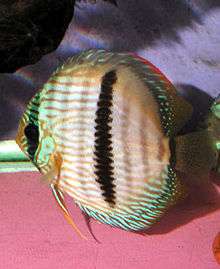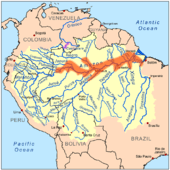Discus (fish)
| Symphysodon | |
|---|---|
 | |
| Symphysodon aequifasciatus | |
| Scientific classification | |
| Kingdom: | Animalia |
| Phylum: | Chordata |
| Class: | Actinopterygii |
| Order: | Perciformes |
| Family: | Cichlidae |
| Tribe: | Heroini |
| Genus: | Symphysodon Heckel, 1840 |
| Type species | |
| Symphysodon discus Heckel, 1840 | |
| Species | |
|
See text | |
Symphysodon, colloquially known as discus, is a genus of cichlids native to the Amazon river basin in South America. Due to their distinctive shape and bright colors, discus are popular as freshwater aquarium fish, and their aquaculture in several countries in Asia is a major industry.[1][2][3][4] They are sometimes referred to as pompadour fish.[5][6]
Species
Following a review published in 2006,[7] three species are recognized by FishBase:[8]
- Symphysodon aequifasciatus Pellegrin, 1904 (Blue discus or brown discus)
- Symphysodon discus Heckel, 1840 (Red discus or Heckel discus)
- Symphysodon tarzoo E. Lyons, 1959 (Green discus)
Taxonomy

Discus are fish from the genus Symphysodon, which currently includes the species S. aequifasciatus, S. discus and S. tarzoo, based on a taxonomic review published in 2006.[7][9] A review published in 2007 largely came to the same result, but differed in nomenclature, as the species called S. tarzoo in the 2006 study was called S. aequifasciatus in the 2007 study, and S. aequifasciatus in 2006 was S. haraldi in 2007.[10][11] Further arguments have been made that S. tarzoo was not described in accordance with ICZN rules and thus should be considered invalid and replaced with S. haraldi,[12] currently considered a synonym of S. aequifasciatus by FishBase.
Other (sub)species have been proposed, but morphometric data (unlike in Pterophyllum, the freshwater angelfish) varies as much between individuals from one location as across the whole range of all discus fish species. S. tarzoo was described in 1959 and applies to the red-spotted western population. S. aequifasciatus and S. discus, meanwhile, seem to hybridise frequently in the wild or have diverged recently, as they lack mitochondrial DNA lineage sorting but differ in color pattern and have dissimilar chromosomal translocation patterns. S. discus occurs mainly in the Rio Negro. Whether S. haraldi is indeed distinct from S. aequifasciatus remains to be determined; if valid it is widespread but it might just be a color morph.
A molecular study in 2011 found five main groups, which generally matched previously recognized phenotypes. They recognized them as evolutionarily significant units and species.[13] Their assigning of scientific names to species differed to some extent from that used by earlier authors: Heckel (S. discus; Rio Negro, upper Uatumã, Nhamundá, Trombetas and Abacaxis), green (S. tarzoo; West Amazon drainages upriver from the Purus arch), blue (S. sp. 1; central Amazon from Purus arch to the Meeting of Waters), brown (S. aequifasciatus; East Amazon downriver from Meeting of Waters), Xingu group (S. sp. 2; Xingu and Tocantins).[13] The Xingu group currently lacks a scientific name, but it is possible that the correct name for the blue is S. haraldi.[13] This taxonomy with four described valid species, S. discus, S. tarzoo, S. haraldi and S. aequifasciatus, has been adopted by the Catalog of Fishes.[14] Some hybridisation occurs (or has occurred) between the brown discus and neighbouring forms, but overall they maintain their separate evolutionary trajectories.[13]
In addition to the wild discus, several captive variants achieved by selective breeding exists. Based on RAPD sequences, the captive variants popularly known as turquoise, pigeon, ghost, cobalt and solid red are derived from wild green, blue and brown discus (not Heckel discus).[15]
Description
Like cichlids from the genus Pterophyllum (angelfish), all Symphysodon species have a laterally compressed body shape. In contrast to Pterophyllum, however, extended finnage is absent giving Symphysodon a more rounded shape. It is this body shape from which their common name, "discus", is derived. The sides of the fish are frequently patterned in shades of green, red, brown, and blue. Some of the more brightly marked variants are the result of selective breeding by aquarists and do not exist in the wild.[15][16] Discus typically reach up to 12.3–15.2 cm (4.8–6.0 in) in length,[8][17] but captives have been claimed to reach 23 cm (9 in).[18] Adults generally weigh 150–250 g (5.3–8.8 oz).[16] There is no clear sexual dimorphism for this fish, but males may reach a larger size than females.[16] In breeding form varieties, solid red discus (red melon, red cover) females are generally redder than males.
Behavior

Symphysodon are highly social, typically occurring in groups that may number many dozens of individuals, which is unique among cichlids of the Americas.[17] When breeding, the pair moves away from the group, possibly to reduce the risk of cannibalism of the young.[17] As for most cichlids, brood care is highly developed with both the parents caring for the young. Additionally, adult discus produce a secretion through their skin, which the larvae live off during their first four weeks.[19] During the first two weeks, the parents stay near their young allowing them to feed easily. In the last two they swim away, resulting in the young being gradually "weaned off" and starting to fend for themselves.[19] Although rare in fish, more than 30 species of cichlids are known to feed their young with skin secretion to various extent,[19] including Pseudetroplus and Uaru species.[20] Sexual maturity is reached in one year.[17]
Symphysodon primarily feed on algae, other plant material, and detritus (periphyton), but sometimes also eat small invertebrates. Invertebrates can make up 38% of the stomach content found in wild specimens of S. aequifasciatus during the high-water season of their native environment, decreasing during low-water season. However, S. aequifasciatus is an extreme example of the genus in this respect, as most species of Symphysodon consume significantly less invertebrates, or none at all, with invertebrates generally making up a small part of their largely plant-based diet.[17] Unlike more predatory cichlids, Symphysodon have relatively long intestines, typical of an herbivore or plant-dependent omnivore.[17]
Distribution and habitat

Symphysodon species inhabit the margins of floodplain lakes and rivers in the lowland Amazon basin,[17] where it is part of the highly diverse Neotropical fish fauna. S. discus is restricted to blackwater habitats, but periodically these may experience brief floods of whitewater.[10] S. tarzoo is found in both black[10] and whitewater,[7] and S. aequifasciatus also occurs in clearwater.[10] Because of their preference for lentic habitats such as floodplains and flooded forests, whitewater inhabited by discus contain little suspended material (unlike main sections of whitewater rivers).[13]
The three species of Symphysodon have different geographic distributions. S. aequifasciatus occurs in the East Amazon downriver from the Purus arch and S. tarzoo in the West Amazon upriver from the Purus arch.[7] In contrast the distribution of S. discus appears to be limited to the lower reaches of the Rio Negro, upper Uatumã, Nhamundá, Trombetas and Abacaxis Rivers.[7][13]
The Nanay River in far western Amazonas is outside the native range; discus in this river were introduced from stock originating in the Tefé area by an aquarium exporter more than 30 years ago.[10]
See also
References
- ↑ Loiselle, Paul V. (1995). The Cichlid Aquarium. Germany: Tetra Press. ISBN 1-56465-146-0.
- ↑ Sands D (1994) A fishkeepers guide to Central American cichlids. Tetra Press. Belgium pg 59-60.
- ↑ Mills D (1993) Aquarium Fish Harper Collins ISBN 0-7322-5012-9
- ↑ Chong, K.; Ying, T. S.; Foo, J.; Jin, L. J.; Chong, A. (2005-09-12). "Characterisation of proteins in epidermal mucus of discus fish (Symphysodon spp.) during parental phase". Aquaculture. 249: 469–476. doi:10.1016/j.aquaculture.2005.02.045.
- ↑ Discus fish - Page 5 Thomas A. Giovanetti, Matthew M. Vriends - 1991 "It was not until the 1930s and 1940s that aquarium-fish dealers began importing discus into Europe and the United States under the common name "pompadour fish." Discus are cichlids, which often surprises many aquarists."
- ↑ International Wildlife Encyclopedia Set - Page 2006 Robert Burton, Maurice Burton, 2002 "Popular aquarium fish because of their bright colors and attractive patterns, pompadour fish are actually quite difficult to keep and require frequent water changes. Pictured are a group of red discus, one of the two species of pompadour fish."
- 1 2 3 4 5 Ready, J.S.; Ferreira, E.J.G.; Kullander, S.O. (2006). "Discus fishes: mitochondrial DNA evidence for a phylogeographic barrier in the Amazonian genus Symphysodon (Teleostei: Cichlidae)". Fish Biology. 69: 200–211. doi:10.1111/j.1095-8649.2006.01232.x.
- 1 2 Froese, Rainer, and Daniel Pauly, eds. (2013). Species of Symphysodon in FishBase. April 2013 version.
- ↑ "New Discus named Symphysodon tarzoo". Matt Clarke. practical fishkeeping. 2006-11-28. Archived from the original on March 7, 2009. Retrieved 15 August 2009.
- 1 2 3 4 5 Bleher, H.; Stölting, K.N.; Salzburger, W.; Meyer, A. (2007). "Revision of the genus Symphysodon Heckel, 1840 (Teleostei: Perciformes: Cichlidae) based on molecular and morphological characters". Aqua. 12: 133–174.
- ↑ "Discus genus revised". Matt Clarke. Practical Fishkeeping. 2007-08-08. Archived from the original on 6 November 2011. Retrieved 15 August 2009.
- ↑ Geerts, M. (2011): On the name Symphysodon Discus Tarzoo. The Cichlid Room Companion
- 1 2 3 4 5 6 Amado, M.V.; Farias, I.P.; Hrbek, T. (2011). "A Molecular Perspective on Systematics, Taxonomy and Classification Amazonian Discus Fishes of the Genus Symphysodon". International Journal Of Evolutionary Biology: 1–16. doi:10.4061/2011/360654.
- ↑ Eschmeyer, W.N.; Fricke, R.; van der Laan, R. (3 January 2017). "Symphysodon". Catalog of Fishes. California Academy of Sciences. Retrieved 26 January 2017.
- 1 2 Koh, T.L.; Khoo, G.; Fan, L.Q.; Phang, V.P.E. (1999). "Genetic diversity among wild forms and cultivated varieties of Discus (Symphysodon spp.) as revealed by Random Amplified Polymorphic DNA (RAPD) fingerprinting". Aquaculture. 173 (1): 485–497. doi:10.1016/S0044-8486(98)00478-5.
- 1 2 3 Livengood, E.J.; Ohs, C.L.; Chapman, F.A. (2009). "Candidate Species for Florida Aquaculture: Discus Symphysodon spp., a Profitable but Challenging Species for Florida Aquaculture". U.S. Department of Agriculture, UF/IFAS Extension Service, University of Florida. Retrieved 25 January 2017.
- 1 2 3 4 5 6 7 Crampton (2008). "Ecology and life history of an Amazon floodplain cichlid: the discus fish Symphysodon (Perciformes: Cichlidae)". Neotrop. ichthyol. 6 (4): 599–612. doi:10.1590/S1679-62252008000400008.
- ↑ "Discus". Seriously Fish. Retrieved 25 January 2017.
- 1 2 3 Buckley, J.; Maunder, R. J.; Foey, A.; Pearce, J.; Val, A. L.; Sloman, K. A. (2010). "Biparental mucus feeding: a unique example of parental care in an Amazonian cichlid". J. Exp. Biol. 213: 3787–3795. doi:10.1242/jeb.042929.
- ↑ Leibel, W. (2010). "Cichlids of the Americas - Mouthbrooders". FishChanel. Retrieved 22 January 2017.
External links
| Wikimedia Commons has media related to Symphysodon. |
| Wikispecies has information related to: Symphysodon |
- Discus photogallery from Club Live World
- Discus Society Malaysia
- Fanatik-Discus-International informations, pictures, videos about discus fish